商标翻译与文化研究
- 格式:doc
- 大小:26.50 KB
- 文档页数:7
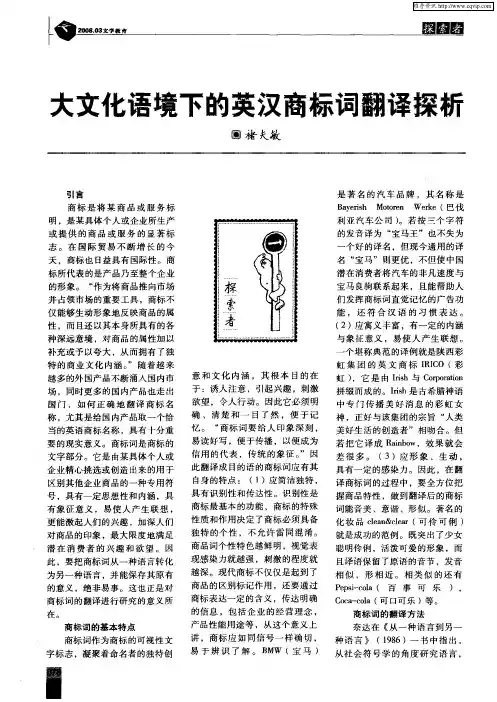
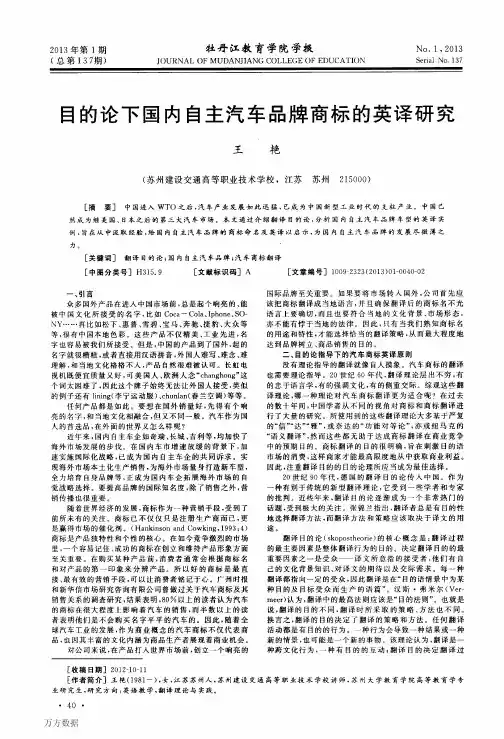
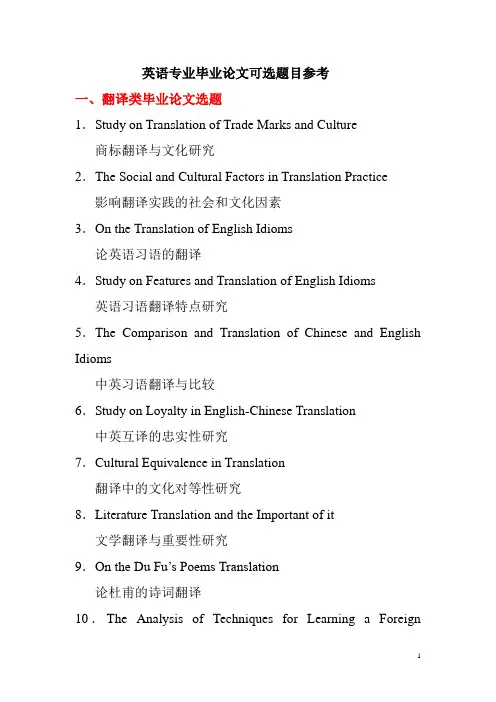
英语专业毕业论文可选题目参考一、翻译类毕业论文选题1.Study on Translation of Trade Marks and Culture 商标翻译与文化研究2.The Social and Cultural Factors in Translation Practice 影响翻译实践的社会和文化因素3.On the Translation of English Idioms论英语习语的翻译4.Study on Features and Translation of English Idioms 英语习语翻译特点研究5.The Comparison and Translation of Chinese and English Idioms中英习语翻译与比较6.Study on Loyalty in English-Chinese Translation 中英互译的忠实性研究7.Cultural Equivalence in Translation翻译中的文化对等性研究8.Literature Translation and the Important of it文学翻译与重要性研究9.On the Du Fu’s Poems Translation论杜甫的诗词翻译10.The Analysis of Techniques for Learning a ForeignLanguage Through Translation通过翻译学习外语的技巧分析11.Cultural Differences and Translation in Chinese and English Color words中英颜色词的文化差异及翻译12.An Cultural Perspective on Untranslatability翻译中不可译性的文化阐释13.Cultural Connotation and Translation in Chinese and English Animals浅论翻译中的译者主体性发挥的度14.On Degree of Translator's Subjectivity in Translation 修辞策略在广告英语中的效用探究15.A Probe of the Effect of Rhetorical Devices in English Advertisement16.Error Analysis of the English Translation of the Information about Scenic Spots in Wuhan武汉旅游景点资料的英译错误分析17.Semantic--Transliteration-the Most Favorable Method for Translating Foreign Words intoChinese音意兼译—外来词中译之首选方法18.A Tentative Study on the Cohesion and Coherence in Sun Zhili’s Chinese Translation of Prideand Prejudice浅论《傲慢与偏见》孙致礼中译本的衔接与连贯19.Chinese Translation of Attributive Clauses in English for Science and Technology科技英语中定语从句的汉译20.Film Titles and Their Translation——A cross-cultural perspective从跨文化角度分析电影片名及其翻译21.Translating Expressions on Public Signs from Chinese into English汉语公示语英译22.论文化差异与翻译Cultural differences and translation23.商标名的翻译原则与品牌文化The Translation Principle of Brand Names and Brand Culture24.英文电影片名的翻译策略与翻译方法研究On Translation of English Film Names25.意美、音美、形美--英文商标的汉译Beauty in Sense, Sound and Form--On Translation of English Trademarks into Chinese26.中文商标英译探On the Translation of Trademarks from Chinese into English二、文化类毕业论文选题27.国际商务谈判中的双赢语用策略The Win-Win Pragmatic Strategies in International Business Negotiation28.Grice 的合作原则在国际商务谈判中的应用The Application of Grice’s Cooperation Principle in International Business Negotiation29.An Analysis on Differences between Chinese and Western Ideas on Face中西文化面子观差异对比分析30.Differences between Chinese and Western Role Awareness of Women and the Effects on TheirCareer Development 中西文化中女性角色意识差异及其对职业发展影响31.Cultural Obstacles in English Learning英语学习中文化障碍32.Understand Chinese and English Cultural Differences through the Comparison betweenChinese and western Euphemism从中西委婉语的对比透视中西文化差异33.A Comparison between Chinese and English taboos中英禁忌语比较34.A Comparison between Chinese and Western Cultural Differences from the Aspect of Privacyright从隐私权看中西文化差异35.A Comparison Between Chinese and Western Social Conventions中西社会习俗比较36.Speech Act and its Application言语行为理论及其应用37.A Survey on the Students’ English Autonomous Learning in Hubei University of Economics湖北经济学院英语自主学习现状调查38.A Survey on Bilingual Courses’ Learning in Hubei University of Economics湖北经济学院双语课程学习现状调查39.The Cultural Connotation of English Etymology and the Teaching of English V ocabulary英语词源的文化内涵与词汇教学40.English idioms—A Mirror Reflecting British Culture 英语习语与英国文化反映41.On Values of Chinese from Perspective of Lexicon从词汇角度读中国人的价值观42.On Cultural Differences of Body Language between English and Chinese论中英体态语文化差异43.The Analysis on the Differences of Interpersonal Relationship between Eastern and WesternPeople东西方人际关系要素差异探析44.Approach to Cultural Differences in Sino-U.S. Business Negotiation and its Impacts中美商务谈判中的文化差异及其影响探析45.Asymmetrical Features of Politeness Principle in Cross-cultural Communication跨文化交际中的礼貌原则的非对称性研究46.English and Chinese Euphemisms: A Comparison between Their Cultural Implications从英汉委婉语对比中透析中西文化差异47.On the Cultural Differences of the Etiquette Norms in Chinese and English NonverbalCommunication 中英非语言交际礼俗规范的文化差异研究48.A Comparative Study on the Different Cultural Connotationsof Basic Chinese and EnglishColor Words英汉基本颜色词文化内涵对比研究49.Characteristic and Cultural Differences of the English and Chinese Idioms中英文习语的特点以及文化差异50.Chinese and Western Culture Values in Advertising Language从广告语中看中西方文化观51.The Differences of Family Values between China and American中国和美国家庭观差异52.The Comparison of Chinese and Western Interpersonal Relationships中西人际关系比较53.Cultural Difference Between Chinese and English on Politeness从中英文礼貌用语中看文化差异54.On Face Perception in Cross-cultural Communication 谈跨文化交际中的“面子”观55.The Application of Euphemism in Cross-cultural Communication委婉语在跨文化交际中的应用56.Differences and Similarities between Eastern and Western Cultures in Chinese and EnglishIdioms从英汉习语看东西方文化异同57.A Contrastive Study of Politeness in English and Chinese Cultures中英文化中的礼貌对比研究58.The Study of Pragmatic Failure: From the Perspective of Cultural Differences解析文化差异引起的语用失误59.On the Sexism in Chinese and English from the Cultural Perspective从文化角度论英汉语中的性别歧视60.Approach to Cultural Factors for the Sino-American Business Negotiation中美商务谈判中的文化因素探析61.A contrastive study of apologies in English and Chinese 英汉道歉语的对比研究62.跨文化交际中颜色词的运用Application of colors in intercultural communication63.英汉寒暄语的差异研究Some difference of small talks between Chinese and English 64.不同交际风格中恭维语及其回应的研究Compliment and its response with different communication styles65.英汉动物词汇文化内涵意义对比研究The cultural connotations of animals in Chinese and English 66.英语委婉语的功能与效果研究On functions and effects of euphemism in English67.中外幽默的跨文化对比A intercultural comparison between Chinese and foreign humor 68.英语副语言交际研究A survey on communication of paralanguage三、语言类毕业论文选题69.The function of context in discourse analysis语篇分析中的语境功能研究70.Discourse analysis in the application of teaching English reading语篇分析在英语阅读教学中的运用研究71.An analysis on the feature of English advertisement 英语广告语言特点分析72.Nov-verbal communication and gesture language 非语言交际与身势语研究73.About English euphemism英语委婉语研究74.On Puns in English Advertisements—from the Perspective of Relevance Theory从关联理论看英语广告双关语75.(My) Dialects and its Negative Effect upon English Pronunciation Learning(本人)方言及其对英语语音学习的负面影响76.A Comparative Study of Euphemisms in English and Chinese英汉委婉语对比研究77.A Study of Sexism in the English Language英语语言中的性别歧视研究78.Thematic Theory and Its implications to English Writing 主位理论及其对英语写作的启示79.Research on the Ways of Rejection in English英语拒绝方式研究80.On the Cultural Values in the Advertisements of China and US论中美广告中所反映的文化价值观81.Semantic Evolution of A Word or Phrase from the Perspective of History从历史文化的发展看某个英语词或短语的语义演变82.The Reflection of Social Inequality in American English 社会不平等现象在美国英语中的反映83.Language Features of English Financial Report 英语财经报道的语言特点四、英语教育类毕业论文选题84.Body Language in English Teaching英语教学中的身体语言研究85.The Diversification of English Language Teaching 英语教学多样性研究86.The Present Situation of Bilingual Education in China 中国双语教学现状研究87.Culture and English Teaching文化与英语教学88.Consideration on Bilingual Teaching双语教学的思考89.The English Teaching Based on Multimedia基于多媒体的英语教学90.Cultural Difference and English Teaching文化差异与英语教学91.Cross-cultural Communication and English Teaching 跨文化交际与英语教学92.Some Designs on English Learning in school中学英语教学设计93.The Contrast of Middle School Education between China & West中西方中学教育对比研究94.The Practice of English Class Teaching英语课堂教学实践95.English Classroom Teaching: Teacher-dominant or Student-centered英语课堂教学——教师主宰还是学生中心96.Personality Factors to the Success of Foreign Language Learning个性因素在外语学习中的作用98.The Application of Communicative Approach Techniques in English Learning交际法手段在英语学习中的运用99.On the Reading Strategies of English as a Foreign language 谈英语的阅读策略100.Cultural influence on English Reading论文化背景知识在英语阅读中的作用101.On basic qualities of a successful English teacher 论英语教师的基本素质102.On the principle of adhering to student-centred teaching 论以学生为中心的教学原则103. On the principle of combining restriction and utilization of native language in foreignlanguage teaching 论在外语教学中控制和利用母语的原则104. Applying the Communicative Approach in the middle school English teaching交际法在中学英语教学的运用105. Cultivating students’ reading skills in English text teaching in middle school在中学英语课文教学中培养学生的阅读技巧106. Analysis of Factors Influencing College Student on Autonomous English Learning影响大学生英语自主学习的因素分析107. Evaluation of Autonomous English Learning自主英语学习的质量评估108. Application of Internet and Multi-media in English Teaching网络多媒体在英语教学中的应用109. A Survey Research on Relevance between English vocabulary and reading ability词汇量与英语阅读能力的相关性调查研究110. A Survey of using College English Network Platform 大学英语网络学习平台使用情况调查研究111. The Effect of Conceptual Metaphor Theory on the English V ocabulary Acquisition of ChineseSenior High School Students 概念隐喻理论对中国高中生英语词汇习得的影响112. Negative Transfer of Native Language in Chinese Senior High School Students' EFL Writingand Its Implications to the English Language Teaching中国高中生英语写作中的母语负迁移及其对英语教学的启示113. On Developing Communicative Competence in Teaching English to Chinese High SchoolStudents 论中国中学英语教学中学生交际能力的培养114. An Investigation of V ocabulary Learning Strategies Taken by Chinese Senior High SchoolStudents 中国高中生英语词汇学习策略调查115. An Investigation of the English Learning Motivation of Three-year College Students and ItsImplications for English Language Teaching大专生英语学习动机调查研究及其对英语教学的启示116. A Survey on the Attitude towards Learner Autonomy of Non-English Majors in theUniversity of Economics经济院校非英语专业学生自主学习态度调查研究117. A Survey on the Use of Multimedia Learning CD by College Non-English Majors大学生使用英语多媒体学习光盘现状的调查研究118. On the Role and Functions of Teachers, Teaching Materials and Learners in theMultimedia-aided English Classroom论多媒体辅助英语教学环境下教师、教材和学生的角色与作用119. The Effect on English Listening Comprehension from Pragmatic Interference语用推理对英语听力理解的影响120. On the Cultivating of Learner’s Writing Competence in Teaching Reading论阅读理解教学中学习者写作能力的培养五、英语文学类毕业论文选题121. The Independent Spirit of Hester Brynne in The Scarlet Letter《红字》中海丝特。

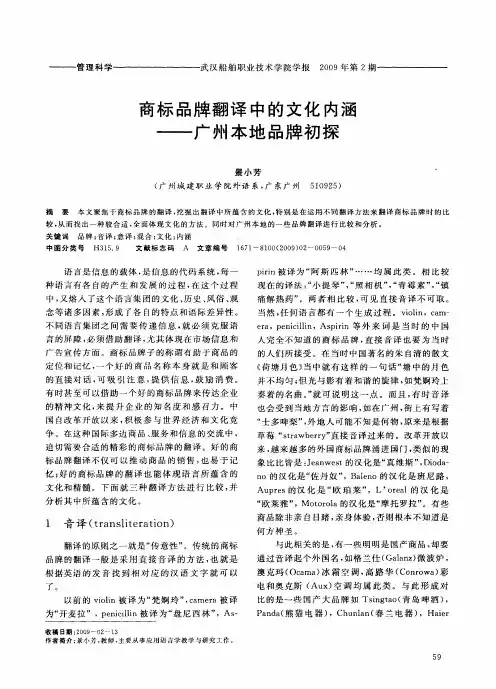
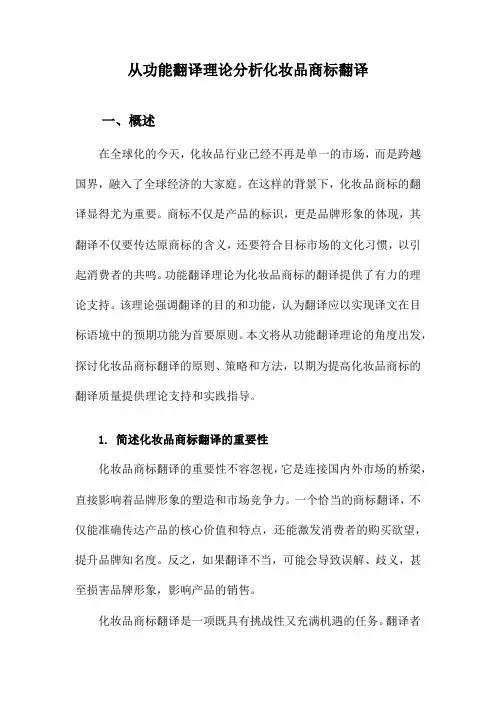
从功能翻译理论分析化妆品商标翻译一、概述在全球化的今天,化妆品行业已经不再是单一的市场,而是跨越国界,融入了全球经济的大家庭。
在这样的背景下,化妆品商标的翻译显得尤为重要。
商标不仅是产品的标识,更是品牌形象的体现,其翻译不仅要传达原商标的含义,还要符合目标市场的文化习惯,以引起消费者的共鸣。
功能翻译理论为化妆品商标的翻译提供了有力的理论支持。
该理论强调翻译的目的和功能,认为翻译应以实现译文在目标语境中的预期功能为首要原则。
本文将从功能翻译理论的角度出发,探讨化妆品商标翻译的原则、策略和方法,以期为提高化妆品商标的翻译质量提供理论支持和实践指导。
1. 简述化妆品商标翻译的重要性化妆品商标翻译的重要性不容忽视,它是连接国内外市场的桥梁,直接影响着品牌形象的塑造和市场竞争力。
一个恰当的商标翻译,不仅能准确传达产品的核心价值和特点,还能激发消费者的购买欲望,提升品牌知名度。
反之,如果翻译不当,可能会导致误解、歧义,甚至损害品牌形象,影响产品的销售。
化妆品商标翻译是一项既具有挑战性又充满机遇的任务。
翻译者需要在深入理解源语言和目标语言文化的基础上,运用专业的翻译技巧和策略,确保商标译名既准确传达了原意,又符合目标市场的审美和习惯。
只有才能确保化妆品商标翻译在品牌国际化、形象塑造和市场推广等方面发挥最大的作用。
2. 功能翻译理论的基本概念和特点功能翻译理论,作为一种翻译理论框架,其核心概念在于强调翻译的目的和功能,而非仅仅追求文本的对等。
该理论认为,翻译是一种有目的的交际行为,其首要原则是“目的法则”,即翻译应服务于翻译行为所要达到的目的。
在这一理论框架内,翻译不再被视为简单的语言转换,而是跨文化、跨语言的交际活动。
功能翻译理论的特点之一是其灵活性。
它不再局限于传统的对等理论,而是允许译者在翻译过程中根据目标文本的预期功能进行调整和创新。
这种灵活性使得翻译更加适应不同的文化和社会背景,确保信息在传递过程中不失真。
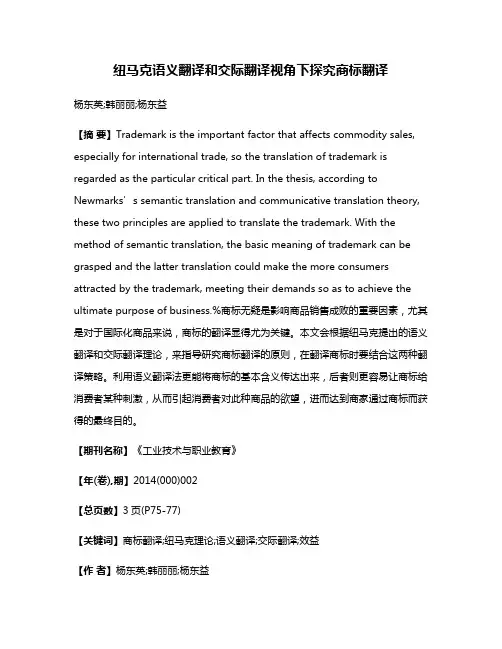
纽马克语义翻译和交际翻译视角下探究商标翻译杨东英;韩丽丽;杨东益【摘要】Trademark is the important factor that affects commodity sales, especially for international trade, so the translation of trademark is regarded as the particular critical part. In the thesis, according to Newmarks’s semantic translation and communicative translation theory, these two principles are applied to translate the trademark. With the method of semantic translation, the basic meaning of trademark can be grasped and the latter translation could make the more consumers attracted by the trademark, meeting their demands so as to achieve the ultimate purpose of business.%商标无疑是影响商品销售成败的重要因素,尤其是对于国际化商品来说,商标的翻译显得尤为关键。
本文会根据纽马克提出的语义翻译和交际翻译理论,来指导研究商标翻译的原则,在翻译商标时要结合这两种翻译策略。
利用语义翻译法更能将商标的基本含义传达出来,后者则更容易让商标给消费者某种刺激,从而引起消费者对此种商品的欲望,进而达到商家通过商标而获得的最终目的。
【期刊名称】《工业技术与职业教育》【年(卷),期】2014(000)002【总页数】3页(P75-77)【关键词】商标翻译;纽马克理论;语义翻译;交际翻译;效益【作者】杨东英;韩丽丽;杨东益【作者单位】河北联合大学外国语学院,河北唐山 063009;河北联合大学外国语学院,河北唐山 063009;唐山工业职业技术学院,河北唐山 063020【正文语种】中文【中图分类】H1591 纽马克翻译理论在翻译界,纽马克作为一名杰出的理论兼教育家,一直以来都是看重理论和实践的融合。
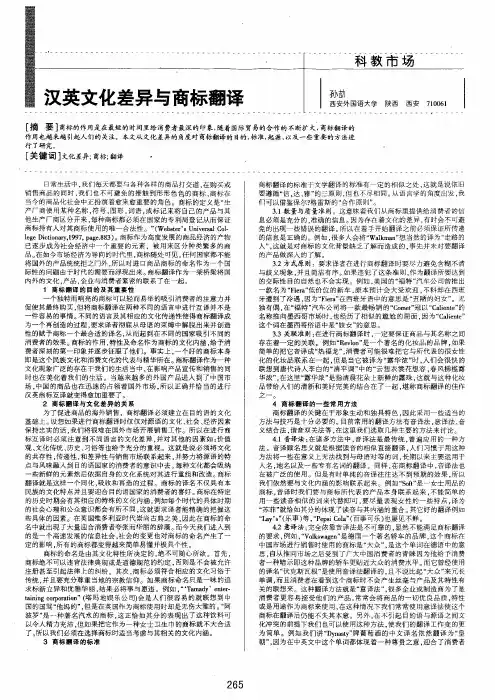
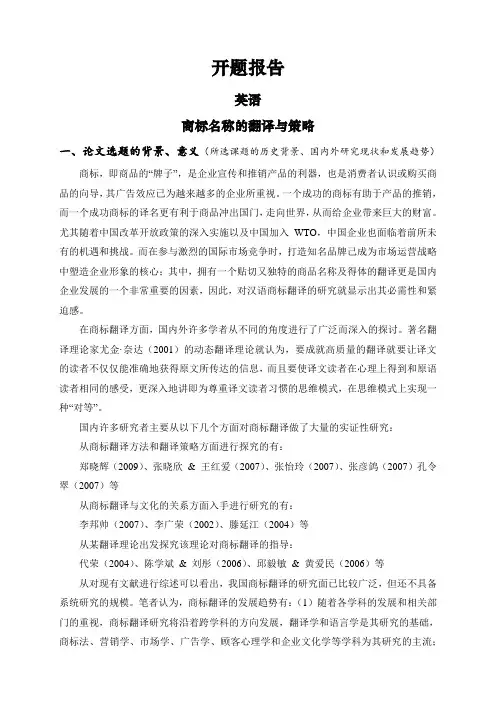
开题报告英语商标名称的翻译与策略一、论文选题的背景、意义(所选课题的历史背景、国内外研究现状和发展趋势)商标,即商品的“牌子”,是企业宣传和推销产品的利器,也是消费者认识或购买商品的向导,其广告效应已为越来越多的企业所重视。
一个成功的商标有助于产品的推销,而一个成功商标的译名更有利于商品冲出国门,走向世界,从而给企业带来巨大的财富。
尤其随着中国改革开放政策的深入实施以及中国加入WTO,中国企业也面临着前所未有的机遇和挑战。
而在参与激烈的国际市场竞争时,打造知名品牌己成为市场运营战略中塑造企业形象的核心;其中,拥有一个贴切又独特的商品名称及得体的翻译更是国内企业发展的一个非常重要的因素,因此,对汉语商标翻译的研究就显示出其必需性和紧迫感。
在商标翻译方面,国内外许多学者从不同的角度进行了广泛而深入的探讨。
著名翻译理论家尤金·奈达(2001)的动态翻译理论就认为,要成就高质量的翻译就要让译文的读者不仅仅能准确地获得原文所传达的信息,而且要使译文读者在心理上得到和原语读者相同的感受,更深入地讲即为尊重译文读者习惯的思维模式,在思维模式上实现一种“对等”。
国内许多研究者主要从以下几个方面对商标翻译做了大量的实证性研究:从商标翻译方法和翻译策略方面进行探究的有:郑晓辉(2009)、张晓欣& 王红爱(2007)、张怡玲(2007)、张彦鸽(2007)孔令翠(2007)等从商标翻译与文化的关系方面入手进行研究的有:李邦帅(2007)、李广荣(2002)、滕延江(2004)等从某翻译理论出发探究该理论对商标翻译的指导:代荣(2004)、陈学斌& 刘彤(2006)、邱毅敏& 黄爱民(2006)等从对现有文献进行综述可以看出,我国商标翻译的研究面已比较广泛,但还不具备系统研究的规模。
笔者认为,商标翻译的发展趋势有:(1)随着各学科的发展和相关部门的重视,商标翻译研究将沿着跨学科的方向发展,翻译学和语言学是其研究的基础,商标法、营销学、市场学、广告学、顾客心理学和企业文化学等学科为其研究的主流;(2)翻译理论在商标翻译中的运用将进一步地全面和深化;(3)中西方文化的影响将是今后商标翻译研究的重点。
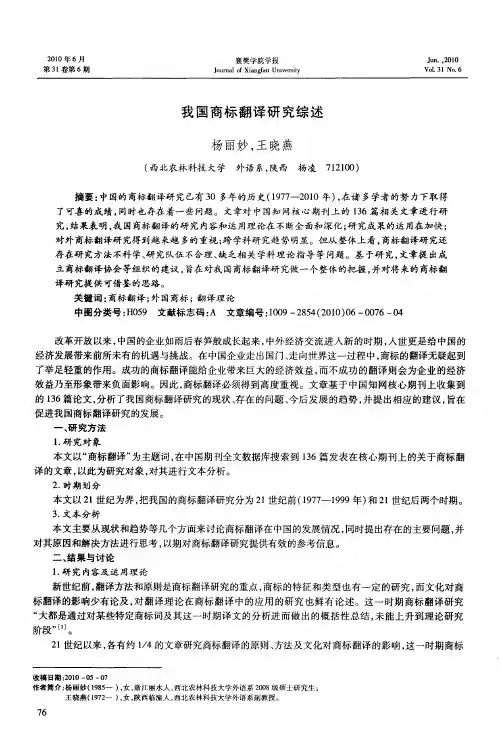
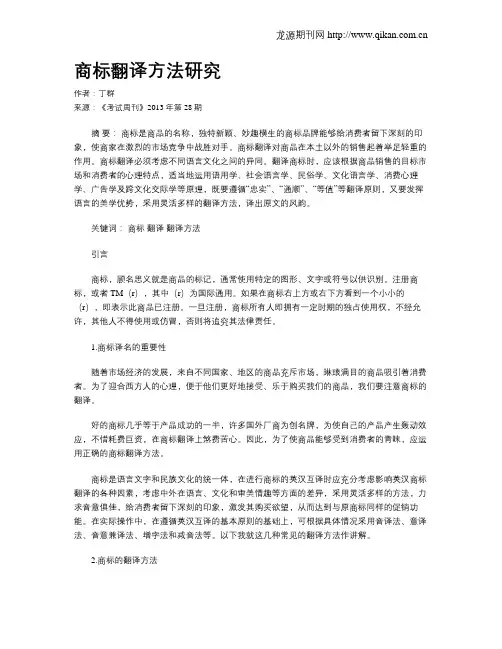
商标翻译方法研究作者:丁群来源:《考试周刊》2013年第28期摘要:商标是商品的名称,独特新颖、妙趣横生的商标品牌能够给消费者留下深刻的印象,使商家在激烈的市场竞争中战胜对手。
商标翻译对商品在本土以外的销售起着举足轻重的作用。
商标翻译必须考虑不同语言文化之间的异同。
翻译商标时,应该根据商品销售的目标市场和消费者的心理特点,适当地运用语用学、社会语言学、民俗学、文化语言学、消费心理学、广告学及跨文化交际学等原理,既要遵循“忠实”、“通顺”、“等值”等翻译原则,又要发挥语言的美学优势,采用灵活多样的翻译方法,译出原文的风韵。
关键词:商标翻译翻译方法引言商标,顾名思义就是商品的标记,通常使用特定的图形、文字或符号以供识别。
注册商标,或者TM(r),其中(r)为国际通用。
如果在商标右上方或右下方看到一个小小的(r),即表示此商品已注册。
一旦注册,商标所有人即拥有一定时期的独占使用权,不经允许,其他人不得使用或仿冒,否则将追究其法律责任。
1.商标译名的重要性随着市场经济的发展,来自不同国家、地区的商品充斥市场,琳琅满目的商品吸引着消费者。
为了迎合西方人的心理,便于他们更好地接受、乐于购买我们的商品,我们要注意商标的翻译。
好的商标几乎等于产品成功的一半,许多国外厂商为创名牌,为使自己的产品产生轰动效应,不惜耗费巨资,在商标翻译上煞费苦心。
因此,为了使商品能够受到消费者的青睐,应运用正确的商标翻译方法。
商标是语言文字和民族文化的统一体,在进行商标的英汉互译时应充分考虑影响英汉商标翻译的各种因素,考虑中外在语言、文化和审美情趣等方面的差异,采用灵活多样的方法,力求音意俱佳,给消费者留下深刻的印象,激发其购买欲望,从而达到与原商标同样的促销功能。
在实际操作中,在遵循英汉互译的基本原则的基础上,可根据具体情况采用音译法、意译法、音意兼译法、增字法和减音法等。
以下我就这几种常见的翻译方法作讲解。
2.商标的翻译方法2.1音译法音译法,可分为纯音译法和谐音译法两种。
Wide Angle | 广角MODERN BUSINESS现代商业266中英文商标名称的互译李林颖 湖南工业大学 412007摘要:品牌名称的翻译是跨文化交流的一种形式。
然而,我们把中文商标翻译成英文或把英文商标翻成中文,将会涉及到语言、法律、文化心理、审美情趣和其他一些因素。
翻译者也应注意一些文化禁忌并选择适当的方法来翻译。
当然,品牌翻译不是一件简单的事情。
我们翻译商品名称时,尽可能做到力求完美。
一个好的商品添加一个好名字它的魅力是无穷的。
关键词:中英文商标; 文化; 译法; 禁忌国内国际商业经营中,各类商品都有商标,注册后的商标成为某种产品的专有名字。
人类进入21世纪,国际贸易发展迅速。
当商业合作和进出口规模不断扩大时,国家的边界逐渐淡化。
除了广告媒介,进口和出口的产品是否可以在国外的土地上成功开发市场,品牌名称的翻译正扮演着关键的角色。
商品品牌的名称类似人的名字。
翻译的品牌名称是商品在其他国家的第二名字,其重要性不言而喻。
一、品牌名称的翻译原则一个成功的翻译品牌既要保留原有文字的本质,还要具有与原文相同的影响力,在必须符合消费者名牌心理的同时,还要注意到英语和汉语的文化差异。
(一)品牌名称翻译的广告性质原则翻译后的品牌名称必须确定产品的性质和特点,体现原有的本土化概念,在原文的基础上,起着广泛传播的作用。
同时,译后名称必须符合商品的特性,简洁新颖,发音甜美。
有利于拼、读、写和记忆,并容易使消费者理解,并对商品产生好的印象。
例如,“Dynasty”——英文商标是“皇朝葡萄酒”,让我们不禁联想其古老而神秘的东方国家,因此,我们对良好的陈酒产生好的印象。
“Forever”是“永久自行车”的商标,它符合自行车完美的“经久耐用,直到永远”的广告。
“飞鸽自行车”翻译成“Flying Pigeon”,鸽子是和平的象征,“flying”使自行车的特性变得生动。
“蜂花化妆品”翻译成Bee&Flower”,我们用了以后会感觉舒适和芳香。
商标翻译策略研究随着全球经济一体化和中国改革开放的深入,越来越多的中国企业开始面向全世界。
商标,作为一个企业商品的标志、代表着一个企业的形象,更是对刺激消费,开拓国际市场起着重要的作用。
而在国际贸易中,商标的翻译,作为一种为经济服务的手段,也在一定程度上影响着商品的营销和推广。
也因此,一个企业商标译名的成功与否,直接关系着其国际市场的开拓。
尤其是中国企业更需要一个好的商标译名以增加国内商品在国际市场竞争中的优势。
本文研究了商标的翻译方法和技巧,希望能给国内民族企业以帮助。
一、商标和品牌商标与商品息息相关,是企业推广和销售自家商品的“法宝”。
那么商标是什么?有许多人分不清楚到底什么是商标。
人们普遍认为商标等同于企业的品牌或者是大众常说的“牌子”,其实则不然,品牌(brand)和商标(trademark)绝不是同一个概念。
品牌(brand)包含着品牌名称和品牌标记(即logo)。
品牌名称是品牌中用语言表达的部分,如macdonald(麦当劳)即使这个品牌的名称,而品牌标记则是用图形或符号的部分,如麦当劳黄色的大写英文字母m。
而商标则是一个企业商品的符号,标志。
世界知识产权组织给商标下的定义是:“商标是用来区别某一工业或商业、企业或这种企业集团的商品标志。
”。
(崔立红,2003)。
而在我国,商标则被定义为是个体工商业户、企事业单位给该企业所生产、加工、或销售的商品所注明的一种标记,用来区别自家商品与其他企业的同类商品。
商标一般由文字、图形或者二者的结合所构成。
商标是经过注册后,合法的品牌,只有注册为商标后,品牌才能打入外国市场。
也就是说,商标受到相关法律的保护,是法律术语,而品牌则是商业术语,用以区别同类商品。
二、商标名称的分类通过对商标定义的阐述和分析,不难发现:商标是一个企业的“代言人”,实实在在地影响着企业的生存和发展。
也因此,商标的翻译尤为重要。
商标的译名要简单,醒目,容易使人关注并记住,主要分为以下几种:(一)地名商标。
Cultural Differences in Chinese-English Brand Name’s Translation一、课题(论文)提纲二、内容摘要三、参考文献Cultural Differences in Chinese-English Brand Name’sTranslationAbstract:English and Chinese are two of the major languages in the world, reflecting two main cultures. It is well-known that language is a part of culture and is the carrier of culture as well. Language and culture cannot be separated from each other. Language would be meaningless without culture and the development of culture would be restricted by language. At the same time, translation is not only the bridge between different languages, but also the inter-cultural communication between different cultures. However, translators often encounter some barriers which are caused by cultural differences in the process of cross-cultural translating. This thesis attempts to explore the cultural differences and the cultural impact on brand name’s translation between Chinese and the Western countries through analyzing the characteristics of brand name’s translation. At the same time, the author gives more attention tothe main factors of cultural differences: cultural vacancy and cultural clash. Furthermore, the author analyzes the great influence of cultural factors in the process of brand name’s translation. When translating, translators should adopt some proper and useful strategies to avoid the barriers caused by different cultural backgrounds.Keywords:language; cultural differences; cultural vacancy; cultural clash; brand name’s translationIntroductionAs the increase of international communication, the exported products have become one of the important windows to show the national culture to the ot her countries in recent. However, brand name’s translation involves language and culture, it as a very important cultural communication way, the brand name’s translation is closely related to cultural factors. However, during the process of translation, translators always encounter some difficulties caused by cultural differences. For instance, the translators can not find the equivalents in the target culture, or the translators often encounter some barriers that the connotative meanings of quite a lot of words in source language are in conflict with the connotative meanings of their equivalent words in target language.Then, the aim of this thesis is to probe the differences between the two cultures according to quite a lot of examples of brand name’s trans lation.Cultural vacancy and cultural clash often lead to a lot of difficulties in theprocess of brand name’s translation. And if translators can not deal with the difficulties caused by cultural differences, the consumers in the target market often misunderstand the connotative meanings of the brand names. On the contrary, effective brand name’s translation can help people from the entire world to intercommunicate freely. At the same time, brand name’s translation can make our culture richer and more vivi d, so good brand name’s translation plays an important role in introducing cultural information between two different cultures. In order to find whether the brand names at present market are translated properly or not, this thesis makes a systematic research on cultural differences in brand name’s translation. The study can improve the future intercultural translation into a higher level.Generally speaking, Chinese culture is greatly different from English culture. Due to striking differences between Chinese culture and English culture, barriers often occur in brand name’s translation. This thesis is to study cultural differences in brand name’s translation between China and the Western countries in order to make people realize the important role of culture and help translators to obtain successful brand name’s translation.The developments of the thesis are as follows: first is an introduction to the thesis. After introduction, the first chapter analyzes the close relationship among culture, language and br and name’s translation. Language is shaped by culture, and language carriers culture, spreads culture and helps to develop culture. And culture is learned by language. Language and culture are dependenton each other. The second chapter analyzes the cultural differences between Chinese culture and the Western culture which include cultural vacancy and cultural clash. The third chapter explores the impact of cultural differences on brand name’s translation, which includes different value systems, different customs and habits, and different customer psychology. The fourth chapter is a problem-solving section, which explores the practices of brand name’s translation. Last is conclusion. From the analysis of previous chapters, it emphasizes again that brand name’s translation is a kind of cross-cultural communication. Owing to the close relation between culture and translation, it is impossible to study brand name’s translation without culture.Ⅰ. the Relationship among Language, Culture and Brand Name’s Translation1.1 Literature ReviewAs international trade expanded, the effects of culture are becoming more and more important. Chinese culture and English culture belong to two different systems. This thesis gives more attention to cultural vacancy. The definition of “vacancy” was first proposed by American linguist Charks Hockett in 1950s.He used “random holes in patterns” to describe the language phenomenon when contrasting grammatical patterns of two languages.In China, there exist two main definitions a bout “cultural vacancy”: Wang Bingqin (1995:110) remarks that “vacancy” refers to the cultural vacancy resulting from unintelligible things in SL that will be easily misunderstood at allby target culture receptors. Pan Huixiaand Li Hui(2000:74-77)give this definition that “vacancy” refers to the unique phenomenon of language and culture which is specific to a nation while does not exist in another culture.Although these definitions are expressed in different words, they reflect one fact that cultural vacancy refers to the linguistic and cultural facts which exist in one national culture but default in another due to cultural differences.The author divides the cultural vacancy into two aspects: lexical gap and semantic gap. Since lexical gap is closely related to language and culture, it is basically manifested at the word level and more specifically, to the denotation and connotation of a word between two languages. When mentioning lexical gaps, Professor Lin Dajin uses the term of “Psychological-associate d meaning” in Intercultural Communication Studies(1996:185-188)to distinguish the following five types: total absence of psychological association, the same denotation but different connotations, the same denotation but absent connotations, the same connotation but different denotations, different denotations and different connotations. Semantic gaps resulted from the non-equivalents are manifested in the denotation and the connotation of the words. Some words have less or more connotations in English than in Chinese, or, some words in both languages appear to refer to the same thing on the surface, but actually refer to quite different things. Since the “cultural turn” in the 1990’s, translation concerns not only the transferring between languages, but also the transferring between cultures. The main difficulties in translation comefrom the fact that some words in source language can’t always have their equivalent words in target language. So, during the process of translating, the problem how to deal with the cultural differences is a meaningful task for our study.In terms of translation principles, Bao Huinanstudies C-E brand name’s translation from the perspectives of language and culture. He advances this principle: translators must respect the national psychology and grasp the associative meaning. The chosen words should be simple, brief, and catchy (Bao Huinan, 2001:274-287). Bao Huinan (2001:274-287) agrees that culture plays an important role in brand name’s translation, stresses the importance of an appropriate conversation of cultural meaning and clearly puts forward the opinion that ignoring cultural differences may cause pragmatic failures in brand name’s translation.According to the studies of other scholars, the author attempts to discuss cultural differences in C-E brand name’s translation.1.2 Language and CultureLanguage is a social phenomenon which satisfies human beings’ needs to express culture and create culture. The basic distinction between human beings and animals is that human beings have the ability to make use of language. Language is the central part of people’s social activity. Without language, the literature, sciences and economical systems can not exist. Bloch andTrager (1942:5) have a definition of language that a language is a system of arbitraryvocal symbols used for human beings. And Samovar(2000:120)noted that “A language is a part of a culture and a culture is a part of a language; the two are intricately interwoven so that one cannot separate two without losing the signi ficance of either language or culture.”Culture is a very complex concept. It is the product of the people through their creation work and it plays a significant role in people’s life. It is a system in which people share beliefs, values, customs and behaviors. Many definitions about culture have been given from different fields. The most important definition of culture was given by Edward Tylor,a British scholar in 1871. This definition was widely accepted over a hundred years ago. In the book Primitive Cu lture, he defined culture as “a complex whole which includes knowledge, beliefs, art, morals, law, custom, and any other capabilities and habits acquired by individuals as members of a society(Tylor,1871:36).The fact is that language and culture are closely related to each other and the two factors cannot be separated at any time. And it is generally agreed that it is because of the existing of language, culture can be transmitted from generation to generation through leaning. Therefore, if people want to learn a language, they must know well about the culture, and if people want to know the culture, they must study the language. On the other hand, any change in a culture often embodies corresponding change in its language, and gives rise to new brand names. For instance, when Chinese people are influenced by the Western culture and accept it, some new words in Chinese language appear.Many Chinese words are from the Western religious culture, economical culture and so on. For example, the brand name“奔驰”is t ranslated from the brand name“Benz”.At the same time, it is easy for people to notice this phenomenon that as more and more new brand names appear in Chinese market, language has developed. So, if people are eager to understand a language, they must know well about the culture and the customs of the culture in which the language is spoken. It is very quite reasonable to say that learning a language is to learn the culture and leaning a culture is to lean the language. Therefore, it is very accurate for Nida(2002:146) to conclude that “language and culture often combine in a kind of symbiosis.” Chinese culture and English culture are different. Owing to the differences in the social environment, history, religion and region, cultural differences will be embod ied in language. Take “regional cultural differences” as an example. China is a country based on agriculture, and the majority of the people make a living by farming. So, there are many words and expressions which are related to“牛”, such as, the brand name“红牛”.However, most Westerners do not like to use the word “bull”as the brand name. It is the reason that“牛”has different cultural meanings in the minds of the Westerners because of the different regional cultures. Cultures differ from one another, and each culture is unique. As cultures are diverse, so are languages.1.3 Culture and Brand Name’s TranslationIt is common to assume that cultures differ from each other and eachculture is unique. Nevertheless, in the age of globalization, cultural boundaries are blurred. Translation leads to exchange of cultures between the Chinese culture and the Western culture. From the relationship between language and culture, it is obvious that translation is not only the process of transferring the source language into the target language, but also the process of a mutual communication and exchange of the two different cultures. The main purpose and characteristic of translation are to exchange ideas and cultures. Translation can also be called a “cultural translation”, b ecause culture factor is taken into consideration.The differences between the source culture and the target culture are the main headaches for translators or theorists to bridge the cultural gap. The translation case of“White Elephant”(translated from the Chinese brand name“白象”) is a typical example to indicate the mistranslation between different cultures. Then, translators should be sensitive to cultural differences.Culture is of great importance in brand naming, for the main usage of a brand name is t o attract consumers to purchase, or satisfy the consumers’ needs.A successful brand name will bring benefits to the producers. Today, translators not only face the consumers from the same cultural background, but also consider the needs of consumers from different cultural backgrounds. It is impossible for all consumers from different cultural backgrounds to accept the cultural information which is loaded in brand names. On the other hand, culture is transmitted through brands. Brands, as an important carrier of culturalinformation, indirectly or directly show or influence the cultural meanings of their own nation. Brand name’s translation is regarded as a kind of cross-communication between different cultures.2. Two Aspects of Cultural Differences in Brand Name’s TranslationOwing to the close relationship between culture and language, brand name’s translation is closely related to culture. However, the striking different cultures often bring a lot of difficul ties in the process of brand name’s translation. So, cultural differences are the inevitable problems that translators must consider. To a large extent, cultural differences in brand name’s translation mainly include cultural vacancy and cultural clash.2.1 Cultural VacancyOwing to cultural differences in historical backgrounds, religious beliefs, social culture, value systems, customs and habits, many expressions in source language have no their own equivalents in target language. This phenomenon has brought great barriers in the process of brand name translating. One of them is about “cultural vacancy” which is the main barrier in our cross-cultural translating. Cultural peculiarity is the main factor leading to cultural vacancy, which is the basic exampl e of cultural differences. The definition of “vacancy” was first proposed by American linguist Charks Hockett in 1950s.He used “random holes in patterns” to describe the language phenomenon when contrasting grammatical patterns of two languages.In China, there exist two main definitions about “cultural vacancy” byWang Bingqin(1995:110), “vacancy” refers to the cultural vacancy resulting from unintelligible things in SL that will be easily misunderstood at all by target culture receptors. Pan Huixia and Li hui point out that “The unique phenomenon of language and culture which is specific to a nation while does not exist in another culture”(潘惠霞,李辉,2000:74-77).It is easy for people having the same cultural background to understand the omitted part, but it is very difficult for people from different cultural backgrounds to understand the cultural connotations entailed in brand names. For example,“红豆”in Chinese culture is a symbol for love and missing. But “red bean” in English culture is just for a bowl of red bean stew in a story. Another example is about vocabulary vacancy between the Chinese language and the Western language in brand name’s translation. The following brand names have no equivalents in the Western language, such as“王老吉”(drink)and“稻花香”(alcohol). In this thesis, the author mainly studies cultural vacancy from the following aspects: lexical gap and semantic gap.2.1.1 Lexical GapOwing to the close relationship between culture and language, cultural differences naturally lead to the differences in the aspect of lexicon. China has a long history about 5000 years. And some words which are related to the Chinese long history have rich cultural information. However, most words have no equivalents in the Western language. Therefore, these words cannot be literally translated into the English language. But, as people have strong feelings aboutthese words, these brand names can arouse a good impression on Chinese consumers, such as, “同仁堂”,“王麻子”(scissors),“王老吉”(tea),and so on. Lexical gap may be a major barrier in intercultural communication, and this thesis divides lexical gaps into two main aspects: non-equivalent concept and non-equivalent expression.Non-equivalent concept refers to the fact that a concept which exists in source language is absent in target language. This expression conveys the idea that a term in English or Chinese does not have an equivalent in the other language. In traditional Chinese culture, many words which denote special cultural information have no equivalents in Western cultur e. For example,“淑女屋”(clothing)---(from Shi Jing《诗·周南·关》---窈窕淑女,君子好求),“嫦娥”(moon cake)---(from a mythology--嫦娥奔月),“长城”(electric appliance)---(a symbol of China)are all bestowed with positive culture images. Besides,“粽子”is a very famous traditional food in Ch ina, but there does not exist equivalent of the word“粽子”in the Western language. On the other hand, some English words reflecting the Western culture may be difficult for Chinese people to understand their meanings, as no equivalent lexical words are avail able in the Chinese language. For example, “Jetta” is the brand name for car. Its Chinese name is“捷达”,which means convenient and swift reaching.“Mcdonald”is translated into“麦当劳”,which is a kind of fast food. Apart from these, there exist many examples about non-equivalent concept between English-Chinese brand name’s translation, such as Golf(高尔夫),Hamburger(汉堡包),“Giordano”(左丹奴),“Coca-cola(可口可乐),and“Pizza”(比萨).Non-equivalent expression indicates the fact that the expression of an existing concept is absent. Some word is easy to grasp the meaning of the expression, but it is difficult to translate it into Chinese. This phenomenon occurs in Chinese-English brand name’s translation. For example, in Chinese traditional culture, the term“状元”symbolizes a person who is the best in a national test. Before the emergence of the expression“状元”,we believe that there also exist some words in the Western language which have the same meaning as the word“状元”,such as the words“Champion”and“Number One Scholar”,whereas in the We stern language, there has no word to name these. New expression always enters with a new name, but it really takes time for the natives to get familiar with the new term.2.1.2 Semantic GapIn the 1970s, British linguist Geoffrey Leech published his book Semantics which put the study of meaning in an entire social and cultural framework. He recognized the importance of cultural circumstances in language use and brought semantics into closest contact with people’s cultural life. Due to the close relationship between culture and language, cultural vacancy is the root of semantic gaps. Some words in the source language have no cultural equivalents in the target language. This phenomenon is called semantic gap. In this thesis, semantic gaps between Chinese and English are divided into twogroups: the same denotation, but the different connotations and the same denotation, but the absent connotations.Since human beings contact with animals and plants frequently, we can notice that a lot of names of animals and plants are used in Chinese and English brand names. However, because of different cultures, the connotations of animal words in one language do not necessarily coincide with those in another. The cultural images of animals have many differences in different countries, which affect translation. According to the Bible, “sheep” refers to the kindhearted person. On the contrary,“goat” is compared to the malicious person. Even lamb has its special religious connotation, which is the image of Jesus who suffered a l ot for people. While in the Chinese language, these animal words don’t have such religious meanings. And“羊”(yang)is similar to“祥”(xiang)in pronunciation, so“祥”in the Chinese language indicates good luck. In addition,“玫瑰”and“rose”symbolize“love”in both Chin ese culture and the Western culture, the connotative meanings are different in other aspect. In English culture, the word “rose” used in a certain expression indicates the connotation of“silence” or “secret” ,such as, “under the rose”.So, we can conclude that the non-equivalent in meanings shows this fact that the cultural gap between the Chinese language and the English language exists. During the process of inter-communication of brand names between two cultures, it is inevitable to avoid the cultural gap.2.2 Cultural Clash in Brand Name’s TranslationOwing to the different historical and social development China and English-speaking countries, culture is always nation-specific. So, cultural clashes are inevitable problems which translators have to face. Since language is the carrier of culture, the clashes between Chinese culture and the Western culture are reflected by the clashes between the two different languages:the conflicting denotations, or the conflicting connotations and the same denotation, but conflicting connotations.Because of the differences between the Chinese culture and English culture, people have different value systems and different beliefs. For the same word, people in different cultures may have different associative meanings. Conflict of word meaning is often caused by the abundant cultural connotations of words. For example, in Chinese culture,“白象”is a brand name of batteries. The word“白象”will gives people the feelings of“clean”and“lovely animal”.When“白象”is used to be the brand na me, it was soon accepted by most people. However, in the English culture, “white elephant” symbolizes something useless. If it is translated into“白象”literally, it is certain that the consumers in the English-speaking countries will not be fond of it.As the Chinese culture and English culture belong to two different systems, the associative information of brand names is sometimes contrary to each other. Take the word “dragon” as a typical example. In the minds of Chinese people, “dragon” indicates good luck and fortune in future and symbolizes power. “龙”is even a symbol of China and Chinese people are calledthe “descendants of the Dragon”. It is easy for us to find many expressions related to the word“龙”,such as“真龙天子”,“望子成龙”,“龙腾虎跃”and“生龙活虎”.While in English-speaking countries,“dragon”is regarded as a threatening animal. In the Bible, Satan Devil is compared to “the great dragon”, while those who have killed dragons are called heroes. And the idiom “to show dragon’s teeth” means “to sow the seed of misfortunes”.3.Cultural Impact on Brand Name’s Translation3.1 Different Value SystemsValues are a learned organization of rules for making choices and for resolving conflicts. “These rules teach us what is useful, good, right, wrong, what to strive for, how to li ve our life, and even what to die for” (Samovar, Porter & Stefani,2000:60).In other words, the value system includes people’s opinions about the world, people’s beliefs and so on. In one word, the value system is playing a basic role in deciding people’s b ehaviors and thoughts. Thus, the value system of culture is a very important factor affecting brand name’s translation, for different nations have different behavioral standards.Since individualism is regarded as an important factor of value systems in Western culture, individualism plays a basic role in the establishment of relationship among human beings. Even the Bible carries examples of individualism.The author takes some brand names as examples to prove this phenomenon. Producers support many products or services for consumers topurchase freely, such as“classic Coke”, “King Coke”, and “Diet Coke” .Apart from these, individuals hope to get great achievements, and then they will be thought as the important valuable persons. To meet this value of consumers, there exist many brand names, such as “Pilot”,“Commander” ,and “Hp”.However, individualism is not the driving force in all cultures. The Chinese equivalent of“individualism”is“个人主义”,which is,on the contrary, a negative concept. According to《现代汉语字典》(The Contemporary Chinese Dictionary),“个人主义”has the following explanation:“一切从个人出发,把个人利益放在集体利益之上,只顾自己,不顾别人的错误思想.”(吕叔湘、丁声树,1983:373).Chinese culture put emphasis on social relationships as opposed to Western culture emphasizing on individuals. Obviously, Chinese culture is greatly affected by the thoughts of Confucianism which guide Chinese people to do something properly.3.2 Different Consumer PsychologiesDifferent cultures shape different psychology reaction to the same object. So, same brand names bring about different results in English and Chinese consumer psychology. Consumers’ different cultural environments can in a great degree decide his psychological response to the connotative meanings of a brand name. For instance,“水仙花”(narcissus)in China is esteemed as the flower with such noble characteristics as being neat and graceful that many manufactures would like to adopt it in their brand names. In contrast, the Western consumers are likely to associate it with the images of beautiful youthor self love or excessive self-admiration because the word “narcissus” originates from Narcissus, who was a beautiful youth in Greek mythology. It was said that the beautiful youth fell in love with his reflection in water, died and was turned into a flower with his name. So it is the representative of excessive self-admiration. Now, we can imagine who will buy a product that is quite self-admired.A Chinese enterprise produces a type of toothpaste named“黑妹”,delivering the message that even a girl with black teet h can turn her teeth white if she uses the toothpaste. We can image what response the product would meet if it is translated as“Black Sister” ?It is not only the symbol of disaster but also an offense to the Blacks.Thus, it is highly important to know the psychology structure of the target customers and their psychological response in order to avoid target customers’ misunderstanding of the different psychological structure of the source culture.3.3Different Customs and HabitsIt is well-known that custom is the way of life in a community, and custom includes many aspects, which concerns all kinds of field of social life. Different nations have different customs and habits. People are inclined to purse good luck, which can be reflected in brand names. In China, people often use the numbers“六”,“九”,and“双”to express good luck. Besides, Chinese expression“红喜”refers to getting married, celebrating birthday, giving birthhappily. And the word “红”are frequently used to be brand names to arouse the feelings of happ iness and success on consumers. The brand names“红旗”(car),“红双喜”(shoes),“红塔山”(cigarette),“红蜻蜓”(shoes)are commonly seen in Chinese market. Death is considered as white happiness, as white is frequently the color of mourning in China. Although weddings and funerals can be translated into Chinese“红白喜事”,cultural connotations are lost. If English speakers do not know much about Chinese culture, they can still understand the meaning of“红喜”with the aid of red-letter days, and they will be most surprised at the funer al referred to as“白喜”,which is peculiar to Chinese culture.Different customs and habits may also result in different cultural connotations. Chinese people have special feelings about some animals, especially“龙”.“龙”is the symbol of noble spirit of the nati on and the system of the ancestor or the king of the nation. At the same time, Chinese people take the dragon as the symbol of the Chinese five-thousand-year civilization. In their minds, the dragon will bring good luck to them. That is why Chinese consumers like to purchase the products named after“龙”,such as “金龙鱼”“龙牌”,“飞龙”,“红金龙”.While in English culture,“dragon”does not have this good reputation as it does in China. When the Westerners see the name, they will associate a fierce monster with it. So “dragon” is seldom used as brand name in the English-speaking countries.From the above analyses we can see that correct treatment of the。
商标翻译与文化研究
摘要:商标翻译是将生产的产品以一种独特的文化方
式将消费的信息传递给消费者,针对商品的翻译要以消费者
的需求心理为基础,保证商标的功能文化性。在商标中蕴含
的文化内容往往是丰富多彩的。通过商标翻译对各种文化思
想进行交流和沟通,这不单单是语言文字上的内容交流,更
加是借助文字,提高文化传播思想内容的策略和方法。通过
合理的商标翻译加强文化的交流,达到文化思想共融的效
果。本文将针对商标在翻译过程中需要注意的音译、意译等
方法进行分析,结合各国不同文化进行研究,分析商标翻译
与各国文化的差异性和不同,从文化内容中寻求商标翻译带
给商标的独特性质。
关键词:商标翻译;文化;商品
引言
不论国内还是国外,厂家的商品在经营过程中都要注册
商标,这是确认自己商品的特有性质。通过采用较为特殊或
有一定价值意义的符号、文字、图形、色彩等信息结合组成
具有代表性意义的商品形象图标,从而突出商品特性和形象
特征,确保商标的设计可以满足产品的整体特点。通过商标
的图样,消费者可以直观的认识商品的基础信息,保证商品
信息的及时宣传效果,提高消费者的购买比率。以下将针对
商标翻译的方法与文化的影响关系进行研究,找寻合适的商
标翻译方式,提高产品市场的认同度,从而完成商标翻译的
最终策略。
一、商标翻译与文化的概念
1、商标与文化的关系
商标的产生与文化是相互联系的,一切商品商标都离不
开文化的影响。文化具有独特的发展形势、历史特点、地理
环境要求、生活方式等。不同的商标中蕴含着不同的文化思
想内涵。合理的商标翻译可以传递不同的文化思想内涵,打
破固有的文化壁垒,降低文化差异造成的消费障碍。因此,
合理的商标翻译是加强商品文化内涵,提高商品文化宣传,
加强文化沟通的重要途径。随着国际上全球经济贸易活动频
繁,商品品牌效益的发展离不开合理的商标,商标翻译工作
是沟通各国文化差异问题的最好解决方法,合理的商标翻
译,提高商品品牌效益。商标选择的好坏、商标翻译的成败
直接影响着市场销售的水平,它已经成为了一种无形的企业
资产,为企业品牌产品的宣传提供巨大的广告效用。
语言是文化的载体,而翻译是商品的语言。通过翻译将
商标由一种语言转化为另外一种语言,抓住商品的基础内
涵,同时符合所在文化下消费者的需求心理,从而满足文化
影响下消费市场的需求。不同的文化需要不同的翻译方式,
从而确保消费市场的认知度和认可情况。合理的商标翻译是
文化消费的合理转变,有针对的市场商标翻译,提高产品市
场份额,是合理的商标翻译策略。
2、商标翻译的文化特征
商标的选取一般具有文化的基本特征,这其中包括人文
特征、地理区域特征和意境美学特征。通过合理的商标意思
组织,提高商品的宣传特点。例如,汽车品牌“ford”福特
是以汽车创世人福特的名字命名,西湖龙井品牌是以“西湖”
这个地名命名,美国总统品牌以“Lincoln”命名,“teenmix”
品牌以“天美意”命名,这些都是运用文化、地域、美学等
方法提出的商标翻译特征。增加了商标的人文、地域特点,
加强了消费者对于商标的认识程度,提高美学音律的文化同
步效果,提高商标带给人的意境美、心情美,是国外的商标
品牌赋予本国的文化内涵,提高消费者对于商品的认识水
平,提高消费者对于商品的接受程度,从而增加对于商品质
量的信任程度,提高企业品牌的良好广告宣传。
二、商标翻译与文化的有效结合
商标是消费者识别商品的基础方法之一。在经济快速发
展的市场中,有特点的商标会带给消费者较为深刻的消费印
象,合理的商标翻译直接带来的是不同的音译效果。商标翻
译一般有音译法、意译法和音译相结合的三种方法。
1、采用音译法的商标翻译方法
音译法是通过对原有语音的音节、音调进行合理的联想
和分析,结合整体产品的基础特点,从而找寻出较为合理的、
易于记住的或有特点的商标的翻译方法。这种方法使用于专
属词汇,即在翻译中无法找到对应词汇的人名、地名等。例
如,Nike直接翻译成耐克,New Balance直接译成新百伦,
Belle直接翻译成百丽都是采用了音译的方法。这种音译的方
法的好处是既保证了商品的基础属性,又保证了消费者对于
引进商品的品牌需求,使消费者更加容易接受,从而保证商
品的销售品牌效用。采用音译法的商标特点是翻译简单直
接,保证了品牌原有的商标音调,带有特殊的异域特征,从
而提高消费者的消费兴趣,为消费者留下较为深刻的印象。
通过音译的商标消费者可以对引进品牌商品的文化进行深
入的了解,例如,Lincoln(美国总统),大力神(Hercules)
等,都带有西方的文化内容和人物。
2、采用意译法的商标翻译方法
以商品的宣传和发展意思进行商标翻译是一种直观的
意思表示方法。依照原品牌商品商标的基础意思,结合现有
的方法进行合理的思维创新,从而发挥目标语言翻译的优
势,为消费者留下深刻的产品意思解释。例如,美国电脑公
司的商标以“apple”命名,已经意识解释“苹果”,水果与
电脑的联想促使消费者对其产生浓厚的兴趣,提高消费的品
牌宣传效果。香皂品牌“Safeguard”通过意译为“舒肤佳”,
作为香皂品牌就宣传了商品的功效“舒服”,又告诉消费者
这是一种使用过后会非常舒服的香皂,单通过商标翻译已经
对产品进行了广告宣传,提高了消费者对于产品的认识,为
产品增加内涵。露华浓是一种化妆品品牌,虽然是由“Revlon”
音译过来的,但其中又是有诗意的,即“云想衣裳花想容,
春风拂槛露华浓。若非群玉山头见,会向瑶台月下逢”。由
此可见,意译的品牌效用是不可小觑的。
3、采用音译、意译相互结合的商标翻译方法
音意结合的商标翻译方法是既要有音节上的同音,又要
有意思上的传意。商标翻译要既符合商标的基本特点,符合
商品的设计特征,又要展现商品的民族特色和文化内涵。例
如,可口可乐公司生产的可乐,既保持了产品的音译,又传
达了产品的特点。从而为消费者带来听觉、视觉和思想内涵
的多重广告宣传,告诉消费者产品具有的特点。可口可乐这
个产品带给消费者无尽的联想,为消费者带来了消费享受体
验。博士伦是眼镜品牌中的领头兵,“Bausch & Lomb”翻译
为“博士伦”往往让消费者联想到博士,这带给消费者一种
特殊的好感,戴眼镜的是有学问的形象深入人心。通过音译
和意译,将博士伦眼镜品牌进行品牌消费宣传,提高消费者
对于眼睛品牌的认识,从而占据消费者的消费趋向心理,占
据眼镜消费市场。
结语
随着科技时代的快速发展,企业对于品牌发展中认识到
商标的作用是极其重要的,商标为消费者打开了认识企业产
品发展文化的第一个窗口,合理的认识商标翻译的方法,结
合人文、地域、美学等方法合理的翻译商标意思表示,遵循
合理的翻译原则,提高商标的语言特征,发挥商标翻译的美
学优势,增强商标的文化色彩,从而提高品牌商品在同类产
品中的宣传和认知程度,降低因文化差异带来的商品认识的
不足,防止其影响企业商品的市场推广,营销消费者对商品
的基础认识,影响企业商品的营销。合理的商标翻译增加了
企业在市场的整体占有程度,提高了推销企业产品的速度,
保证了企业产品的广泛宣传,从而更好的完成企业商标翻译
的目的,保证了不同地域、不同文化的消费者可以同时接受
品牌产品带来的物质体验。
参考文献
[1] 奈达 (Eugene A. Nida). 语言与文化:翻译中的语
境. 上海外语教育出版社. 2001
[2] 冯修文. 应用翻译中的审美与文化透视--基于商标
品牌名和品牌广告口号的翻译研究. 上海交通大学出版社.
2010
[3] 夏平, 勒菲弗尔. 历史与文化论集. 上海外语教育
出版社. 2010
[4] 马咏蕾 魏劭农 李超. 品味百年(沪上食品老字号商
标设计). 上海锦绣文章出版社, 2013
作者简介:孙艺原(1992-),女,籍贯辽宁省锦州市,
大学本科学历,英语师范专业。